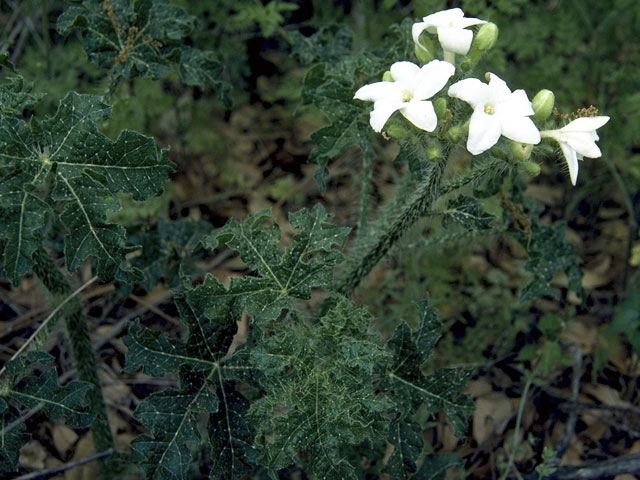Genus Cnidoscolus Rank Species | ||
 | ||
Similar Cnidoscolus, Cnidoscolus stimulosus, Cnidoscolus angustidens, Cnidoscolus urens, Delphinium carolinianum | ||
Cnidoscolus texanus, commonly known as Texas bullnettle, treadsoftly, and mala mujer, is a perennial herb covered with stinging hairs, native to the U.S. states of Texas, Arkansas, Kansas, Louisiana, and Oklahoma. It is also native to the northern Mexican state Tamaulipas. It is an herbaceous flowering plant that grows between 30–80 cm (11.8–31.5 in) tall and as much as 1 m (3.3 ft) across.
Contents
Cnidoscolus texanus has white flowers and blooms all throughout the year. The main stem, branches, and leaves are all covered with hispid or glass-like bristly hairs that release an allergenic toxin upon contact.
It is a drought-tolerant plant, therefore making it a superb choice for xeriscaping. This plant is also attractive to bees and butterflies, among other insects, as well as birds.
Exposure to the plant by contact results in intense pain, burning, and itching and if not treated promptly can cause problems ranging from skin infection to allergic reaction.
Description
It is a perennial plant with erect, branching stems growing from thick root stock. It has milky latex and stiff prickly glandular-based hairs. The leaves are simple and are alternately arranged on the stem, and each leaf is deeply cut with 3 to 5 lobes. The flowers are in a few flowered terminal cymose inflorescence. Flowers have five sepals and lack petals, the sepals are lobed, white, fragrant, and covered with hispid hairs. Each flower has 10 connate stamens. The fruits are prickly 3-seeded capsules and the seeds are consumed by Rio Grande wild turkeys and mourning doves.
It was first described by Johannes Müller Argoviensis in 1865 as Jatropha texana. It was then moved to the genus Cnidoscolus in 1903 by John Kunkel Small.
Bullnettle Exposure
If not treated promptly, the intense burning and stinging from an encounter with a nettle can last well over an hour, and could lead to cellulitis (a type of skin infection) or in rare cases, an allergic reaction. The secretions of the plant cause an intense burning sensation due to their highly acidic pH. The spines themselves provide a vehicle for the plants secretions to make it into the dermal and epidermal layers of the skin. Once the nettles themselves are removed from the skin, a moderately basic preparation such as baking soda mixed with water to form a paste is sufficient enough to neutralize the acidic secretions of the plant, thus stopping the painful burning and itching sensation.
